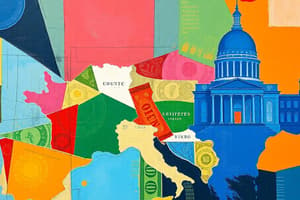Podcast
Questions and Answers
What primarily distinguishes modern currency from earlier forms of money?
What primarily distinguishes modern currency from earlier forms of money?
- It is universally accepted in everyday transactions.
- It is used primarily for trade between countries.
- It does not have intrinsic value of its own. (correct)
- It is made of precious metals.
Who is authorized to issue currency notes in India?
Who is authorized to issue currency notes in India?
- Private banks
- The Reserve Bank of India (correct)
- Foreign governments
- The Ministry of Finance
Why is modern currency accepted as a medium of exchange?
Why is modern currency accepted as a medium of exchange?
- It is backed by gold reserves.
- It is universally recognized by all countries.
- It is authorized by the government. (correct)
- It is made from durable materials.
What does Indian law stipulate about payments made in rupees?
What does Indian law stipulate about payments made in rupees?
In comparison to items such as grain or cattle, how is modern currency characterized?
In comparison to items such as grain or cattle, how is modern currency characterized?
What role does the government play in the acceptance of modern currency?
What role does the government play in the acceptance of modern currency?
What is the significance of the Reserve Bank of India in relation to currency?
What is the significance of the Reserve Bank of India in relation to currency?
How does Indian law affect the acceptance of payments made in rupees?
How does Indian law affect the acceptance of payments made in rupees?
Why can't other individuals or organizations issue currency in India?
Why can't other individuals or organizations issue currency in India?
In what ways does modern currency differ in function from items like grain or cattle?
In what ways does modern currency differ in function from items like grain or cattle?
Flashcards
What makes modern currency a medium of exchange?
What makes modern currency a medium of exchange?
Currency, issued and authorized by the government of a country, is accepted as a medium of exchange due to its legal status.
Who issues currency in India?
Who issues currency in India?
The Reserve Bank of India issues currency notes on behalf of the Indian government. No other individual or organization is allowed to issue currency.
Is there a legal obligation to accept rupees in India?
Is there a legal obligation to accept rupees in India?
Indian law requires accepting rupees as a legal tender for payments. No individual or organization can refuse rupees as a means of payment.
What gives currency intrinsic value?
What gives currency intrinsic value?
Signup and view all the flashcards
What is the difference between modern currency and previous forms of money?
What is the difference between modern currency and previous forms of money?
Signup and view all the flashcards
What makes modern currency valuable?
What makes modern currency valuable?
Signup and view all the flashcards
How does a government give value to its currency?
How does a government give value to its currency?
Signup and view all the flashcards
What is legal tender?
What is legal tender?
Signup and view all the flashcards
Why are rupees widely accepted in India?
Why are rupees widely accepted in India?
Signup and view all the flashcards
Study Notes
Modern Currency Characteristics
- Modern money includes paper notes and coins, which are not made of precious metals like gold, silver, or copper.
- Unlike earlier forms of money (grain, cattle), modern currency has no intrinsic value; it is without any use of its own.
- Modern currency is accepted as a medium of exchange due to government authorization.
- The Reserve Bank of India (RBI) issues currency notes in India on behalf of the central government.
- Indian law prohibits any other entity from issuing currency.
- The law mandates that rupees are legal tender, meaning they cannot be refused in transactions.
- Individuals in India cannot legally refuse payment in rupees.
- Modern currency is widely accepted as a medium of exchange.
Studying That Suits You
Use AI to generate personalized quizzes and flashcards to suit your learning preferences.




